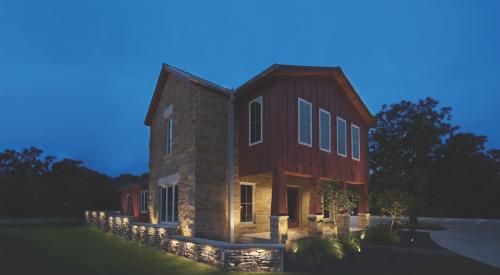Photo courtesy of Philip Wegener Photography
Laying out kitchen lighting correctly is important for the health, safety, and welfare of our clients. The layers of lighting we specify need to be aesthetically pleasing, but they must also be functional.
In their 2015 National Kitchen + Bath Association book, “Kitchen & Bath Lighting,” authors Daniel Blitzer and Tammy MacKay advise, “If you want to provide direct light over a surface, locate luminaires over that surface.” Sounds simple enough. But you see kitchens in countless magazines where the light is anywhere but over the task.
What does effective kitchen lighting look like? Using a recent kitchen remodel my firm completed in Denver’s Stapleton neighborhood, let’s see how to create an effective layout.
There are three large north-facing windows in front of the sink and one facing west. (Natural light is the best light of all.) The hood has four small halogen spots of its own, so it was up to us to lay out recessed cans to light the countertops around the rest of the kitchen and the island.
How much light is adequate? Blitzer and MacKay’s book says (in Table 4.1) that we are required to provide a minimum of 50 foot-candles on the counter for clients under 65. For those older than 65, it should be 100 foot-candles. For this kitchen, with a 9-foot ceiling, the distance from recessed can (in this case we chose a 5-inch diameter) to counter is 6 feet, which we need to know.
We chose a specific lamp, based on performance and price. It is a PAR 30 long neck by Green Creative. It uses just 8.5 watts, puts out 700 lumens of 3000K light (a neutral white), and has a CRI of 80. Based on the space and the lamp’s photometric charts, it will deliver 49 foot-candles to the counter (close enough!) and will have a beam spread of 4.4 feet. (The colored layout shows the beam spread for the cans as placed; ideally the beams will slightly overlap to avoid dark spots.)
The layout of those fixtures is critical; they must be no farther out than the front edge of the countertop to be effective. Any farther apart and a user standing at the counter blocks out most of the light.
The kitchen also has three decorative pendants at the breakfast bar, controlled by their own switch. There are three cans lined up along the brick wall for accent and to shed light on the refrigerator. Can lights line the counters around the sink, wrapping back to the ovens, which are on their own circuit as well. Two cans hit the counters to either side of the cooktop, where the hood has its own lights. Finally, for the lone upper cabinets next to the ovens, there is LED tape tucked under the front edge of the uppers. See illustration and photo above for other lighting tips.
This story originally appeared in the July/August issue of PRODUCTS magazine. See the print version here.














